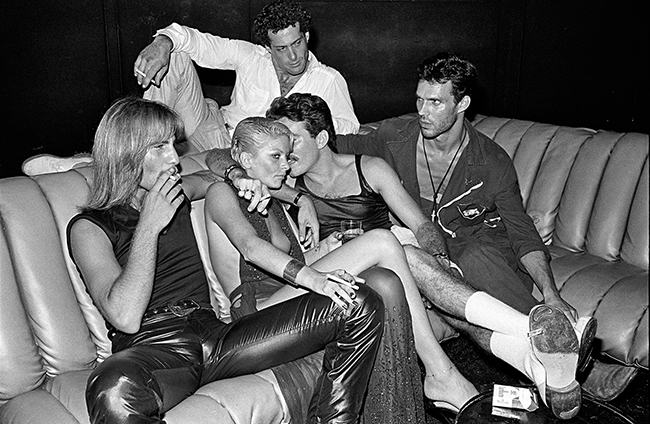In the late 1970s, a unique and magical era unfolded in the heart of New York City, and Bill Bernstein, an award-winning portrait and documentary photographer, was there to capture it with his camera. His lens immortalized the vibrant and extravagant splendor of the disco scene in 1979, providing a captivating visual documentation of a period that defined an iconic chapter in American culture. Bill Bernstein, a renowned American photographer, is not only celebrated for his iconic disco photographs but also for his ability to convey the personalities and emotions of his subjects, from the exuberant nightlife to intimate celebrity portraits.

Bernstein’s journey into the world of photography began when he started his career at the Village Voice in the 1970s. Since then, his methodology has revolved around researching and representing contemporary cultures and subcultures through the lens of his camera. His body of work, represented in the US by TW-fineart and in the UK by the David Hill Gallery, is a testament to his talent in capturing the essence of an era.
One of the most significant chapters in Bernstein’s career is his exploration of New York City’s late 1970s nightclub culture. His photographs from iconic venues like Studio 54, Paradise Garage, and the Mudd Club provide a window into a time when inclusion and freedom of expression reigned supreme. This period was marked by the aftermath of the Stonewall riots and the pre-AIDS era, a time when sexual liberation, Women’s Liberation, Civil Rights, and equality were on full display on the dance floors of these clubs throughout the night.
What sets Bernstein’s work apart is his ability to capture the unguarded moments of his subjects, whether they are rockstars like U2, business magnates like Richard Branson, or the homeless individuals of Bowery Mission. In every photograph, he peels away the public persona to offer glimpses of the real personalities beneath. His work allows celebrities and everyday people to become accessible to viewers, thanks to the immediacy of the moments he captures.
Bernstein’s portfolio extends beyond his disco era photographs. He has served an international advertising and editorial clientele, including names like National Geographic TV, Time Magazine, Elle, New York Philharmonic, and HBO. Additionally, he is the author of four books: “Night Dancin'” (Ballantine Books, 1980), “Each One Believing: Paul McCartney On Stage, Off Stage, and Backstage” (Chronicle Books, 2004), “DISCO: The Bill Bernstein Photographs” (Reel Art Press, 2015), and “Last Dance” (BillBernsteinFineArt.com, 2021). His work has been exhibited globally, making a lasting impact on the art world.
One of the most notable exhibitions of Bernstein’s work was “Night Fever: New York Disco 1977-1979,” held at Manhattan’s Museum of Sex. This exhibition provided a compelling glimpse into the world he documented with his lens. His work has also been featured at The Galerie fuer Moderne Fotografie in Berlin and The David Hill Gallery in London. There was an exhibit at Philharmonie de Paris in May 2019, followed by the London Design Museum in April 2020. Additionally, his work is part of a traveling exhibit for the Vitra Design Museum in Weil am Rhein, Germany, which will be on display in various venues around the world until 2024.
Bernstein’s work is more than just photographs; it’s a window into the past and a celebration of an era where music, fashion, and freedom came together in a vibrant and extravagant mix. His photographs from Studio 54, the legendary nightclub, perfectly encapsulate the spirit of the time. In his photograph titled “Studio 54, Couch, 1979,” we are transported to the heart of Studio 54, a place where a diverse group of individuals comes together to revel in the joy of dance and unabashed freedom of expression.
This particular image features a small group sitting on a couch, discreetly observing the crowd while savoring every moment of the night. What makes this ensemble captivating is the apparent diversity in their sexual orientations. A woman and four men come together to create an aura of decadence and unapologetic self-expression that made Studio 54 famous.
The photograph captures a timeless essence. It’s a window into a world where labels and judgments held little power, and the focus was on celebrating life and self-expression. Studio 54 was a sanctuary for those who wanted to escape the constraints of society, and Bernstein’s lens immortalized the moments of pure, unadulterated joy.
Bill Bernstein’s work continues to be a source of inspiration and a glimpse into a bygone era. His ability to capture not just moments but the emotions and personalities of his subjects is a testament to his skill as a photographer. In an ever-changing world, his photographs stand as a reminder of a time when the dance floor was a place of liberation and the night was filled with feverish energy.
In a world saturated with images, Bill Bernstein’s photographs remain iconic, not just for their aesthetic value but for the stories they tell and the emotions they convey. They are a testament to the power of photography to transport us to a different time and place, to capture the essence of an era, and to remind us of the enduring human spirit that seeks joy, freedom, and connection. Bill Bernstein’s work is a living tribute to the disco era and the indomitable human desire to dance, express, and be free.
